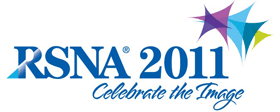
Abstract Archives of the RSNA, 2011
Jiang Du, Presenter: Grant, General Electric Company
Research collaboration, General Electric Company
Won C Bae PhD, Abstract Co-Author: Nothing to Disclose
Chantal Pauli MD, Abstract Co-Author: Nothing to Disclose
Reni Biswas, Abstract Co-Author: Nothing to Disclose
Graeme M. Bydder MBChB, Abstract Co-Author: Research grant, General Electric Company
Christine B. Chung MD, Abstract Co-Author: Nothing to Disclose
In this study an ultrashort TE (UTE) pulse sequence was used with bi-component analysis to quantify both the short (water bound to collagen and proteoglycan) and long T2 (free water) components in articular cartilage and the meniscus of the knee joint in vivo.
A two-dimensional (2D) multi-echo UTE imaging sequence with a minimal TE of 8 μs was implemented on a 3T Signa TwinSpeed scanner (GE Healthcare Technologies, Milwaukee, WI). Four-echo UTE acquisitions were performed with four sets of TEs: (0.008, 4.4, 20, 40 ms); (0.4, 6.6, 25, 50 ms); (0.8, 11, 30, 60 ms); and (2.2, 16, 35, 70 ms), which covered both the short T2 (T2* < 3 ms) and long T2 (T2* > 20 ms) range. Other imaging parameters include: FOV = 14 cm, 2 mm slice thickness, TR = 200 ms, 320 readout, 455 projections, 512×512 reconstruction matrix size, bandwidth = 125 kHz, flip angle = 45º, scan time = 3 min. The total quantification time was 3×4 = 12 minutes. In-house developed bi-component fitting software was used to calculate T2* and fractions of the bound and free water components. Five healthy volunteers were recruited.
High quality UTE images were achieved in all five volunteers without noticeable motion or streak artifact. Excellent bi-component fitting was achieved for femoral and tibial cartilage as well as meniscus. Figure 1A-H shows selected multi-echo UTE images, as well as bi-component analysis at regions of interest drawn in articular cartilage and meniscus with excellent curve-fitting. The bi-component analysis shows predominantly long T2 nature of articular cartilage, which comprises 18% short T2* component (T2*~0.5 ms) and 82% long T2* component (T2*~39 ms), and predominantly short T2 nature of the meniscus, which comprises 47% short T2* component (T2*~2.4 ms) and 53% long T2* component (T2*~24 ms).
Free and bound water quantification of the articular cartilage and meniscus is feasible in vivo by using repeated multi-echo UTE acquisitions with varied TE delays to cover both the short and long T2 ranges. Bi-component analysis provides fast and reliable quantification of the short and long T2* values and the corresponding fractions of each component.
UTE bi-component analysis provides robust evaluation of the short T2* component, which may be important for early evaluation of osteoarthritis.
Du, J,
Bae, W,
Pauli, C,
Biswas, R,
Bydder, G,
Chung, C,
In Vivo Ultrashort TE (UTE) Imaging of the Knee Joint with Bi-component Analysis. Radiological Society of North America 2011 Scientific Assembly and Annual Meeting, November 26 - December 2, 2011 ,Chicago IL.
http://archive.rsna.org/2011/11008724.html

